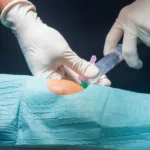

According to Synvisc’s studies, about 7% of patients experienced various Synvisc side effects. These side effects primarily manifested as pain and swelling at the injection site. This statistic highlights Synvisc’s low side effect incidence rate and underscores its safety and effectiveness for patients with early to severe knee osteoarthritis.
Knee osteoarthritis (OA) is prevalent in older individuals, causing chronic pain, swelling, and stiffness. These degenerative joint disease symptoms prompt the search for treatments. Despite potential side effects, Synvisc’s three-injection therapy is often recommended by medical professionals for its safety and effectiveness in providing long-lasting relief to knee OA patients.
In this article, we will delve into Synvisc’s side effects, this injection treatment, and how to effectively manage these post-injection symptoms.
Key Takeaways
- Healthcare providers may recommend Synvisc when first-line OA treatments, such as conservative therapies and simple analgesics, have not relieved patients.
- The most common Synvisc side effects include pain, stiffness, swelling, and fluid buildup around the knee or injection site, usually temporary.
- The affected joint may need some time to adapt to the injected HA substance, leading to knee pain as a Synvisc side effect.
- Applying ice on the knee can help alleviate swelling, and alternating between low-impact activities and resting the knee can help with stiffness.
- Understanding the treatment and its possible side effects empowers patients to make informed healthcare decisions and handle their symptoms effectively.
About: Medica Depot is your trusted all-in-one supplier, offering a range of high-quality medical injectables and supplies. If you’re looking to buy Synvisc wholesale, you can do so on Medica Depot quickly and easily. We offer a worry-free experience in searching for the best and most popular products on the market. Whether for health professionals, plastic surgeons, dermatologists, licensed estheticians, or other specialists, we can offer genuine, brand-name products you may need. With Medica Depot, we prioritize serving you better to improve the patient’s quality of life.
What is Synvisc?
Synvisc is a medical treatment for osteoarthritis, specifically knees. Its ingredients are primarily composed of hyaluronic acid (HA). The joint’s synovial fluid contains HA, which surrounds the joints and lessens friction and pain when moving. Synvisc acts as a lubricant and shock absorber for the joints.
Healthcare providers may recommend Synvisc when first-line OA treatments have not relieved patients. This injection treatment requires three (3) intra-articular injections directly into the affected knee joint, given at a weekly interval. Each Synvisc dosage is 2 mL (16 mg).
Potential Side Effects of Synvisc Injections

While Synvisc is generally well-tolerated and safe for most individuals, patients can still expect various side effects. These symptoms may range from standard to severe, and medical professionals can help manage these reactions.
The most common Synvisc side effects include pain, stiffness, swelling, and fluid buildup around the knee or injection site. These side effects usually do not require medical attention, as they may subside once the body adjusts to the medicine. However, when these persist for longer, immediately contact your trusted provider.
While most Synvisc side effects can range from mild to moderate, severe reactions can rarely occur after treatment. These may include difficulty breathing, hives, allergic reactions, or shortness of breath, requiring immediate medical attention.
According to Synvisc, potential adverse events can occur after this kind of injection therapy or viscosupplementation. It may rarely occur, but patients should immediately address these adverse reactions to avoid further complications, particularly in their health.
- Arthralgia
- Joint stiffness
- Joint effusion
- Joint swelling
- Joint warmth
- Injection site pain
- Arthritis
- Arthropathy
- Gait disturbance
Knee Pain as a Side Effect of Synvisc Injections
Synvisc contains hyaluronic acid (HA), mimicking a natural gel-like substance in the joint’s synovial fluid. While it helps reduce pain and inflammation, it can cause temporary knee pain after injection. The affected joint may need some time to adapt to the injected HA substance, leading to knee pain as a Synvisc side effect.
Normal discomfort includes mild pain at the injection site, which typically disappears within a few days. However, persistent, severe pain and discomfort should require medical attention. To manage this mild pain side effect, ice applied to the knee for 10 minutes can help alleviate the discomfort.
Stiffness and Swelling after Synvisc Injections

According to Drugwatch, about 6% of the clinical trial patients reported various side effects, which went away on their own or with minimal treatment. Post-injection stiffness and swelling in the site can impact patient mobility and comfort. However, it’s worth noting that pain relief may start a few weeks to a month after injections.
When patients experience stiffness and swelling, they are advised to avoid knee-stressing activities for the next 48 hours. Applying ice on the knee can help alleviate swelling, and alternating between low-impact activities and resting the knee can help with stiffness. However, if symptoms persist, consult your healthcare provider.
Managing Synvisc Side Effects for Optimal Patient Outcomes


With these potential Synvisc side effects, patient education is crucial in managing these symptoms. Understanding the treatment and its possible side effects empowers patients to make informed healthcare decisions and handle their symptoms effectively.
Healthcare providers and patients can capitalize on effective communication to allow tailored treatment plans. This collaboration between both parties can ensure the treatment aligns with the patient’s specific needs, desired goals, knee osteoarthritis condition, and overall health status.
Medical professionals can also suggest strategies to minimize risks and address Synvisc’s side effects. While these strategies may depend on each patient’s lifestyle, here are some general tips to help individuals post-injection.
- Staying Active to Maintain Joint Health
- Maintaining Healthy Lifestyle (Weight, Diet, Hydration, etc.)
- Being Proactive about Pain Management
These providers can help patients understand Synvisc and Synvisc One’s pros and cons, informing them about their entire procedure. This can also build trust between providers and patients, increasing their satisfaction with therapy and outcomes.
Conclusion
Synvisc offers a significant medical treatment for knee osteoarthritis (OA). It capitalizes on hyaluronic acid (HA), which resembles the healthy HA in the joint’s synovial fluid and acts as a lubricant and shock absorber. However, it’s necessary to be aware of its potential Synvisc side effects, including pain, stiffness, and swelling at the injection site.
These side effects may affect patient mobility and comfort but are usually temporary and manageable. Effective communication between providers and patients can create a personalized treatment plan and efficiently manage these side effects for optimal outcomes. Always consult your healthcare provider for concerns about Synvisc treatment and side effects.
FAQs
1. What is Synvisc, and what are its side effects?
Synvisc is a type of injectable medication used to treat knee pain caused by osteoarthritis. Some of the side effects of Synvisc include knee pain, stiffness, and swelling. These side effects are usually mild and go away within a few days.
2. How long do the side effects of Synvisc last?
The side effects of Synvisc usually last for a few days and go away on their own. However, you should contact your doctor immediately if you experience severe or prolonged side effects.
3. What can I do to reduce the side effects of Synvisc?
To reduce the side effects of Synvisc, follow the aftercare instructions given by your healthcare provider. These instructions may include applying ice to the knee, resting and avoiding strenuous activity, and taking pain relievers.
References
- Frequently Asked Questions | Synvisc-One® Official Site. (n.d.). Synvisc One. https://www.synviscone.com/what-is-synvisc-one/synvisc-one-faqs
- SYNVISC ® HYLAN G-F 20. (n.d.). In Sanofi US. https://products.sanofi.us/synvisc/synvisc.pdf
Aesthetic supplies USA refers to products and equipment used in the field of aesthetic medicine and cosmetic treatments that are available for purchase in the United States. These supplies encompass a wide range of items necessary for various aesthetic procedures and treatments conducted by professionals such as dermatologists, plastic surgeons, aestheticians, and other qualified practitioners.
Examples of aesthetic supplies include:
-
Dermal Fillers: Injectable substances used to restore volume and reduce wrinkles.
-
Botulinum Toxin (Botox): Injectables used to temporarily relax facial muscles and reduce wrinkles.
-
Laser Devices: Equipment used for hair removal, skin rejuvenation, tattoo removal, and other laser treatments.
-
Chemical Peels: Solutions applied to the skin to exfoliate and improve texture.
-
Microdermabrasion Devices: Tools used for mechanical exfoliation to rejuvenate skin.
-
Microneedling Devices: Devices that create tiny punctures in the skin to stimulate collagen production.
-
Cosmeceuticals: Skincare products that contain biologically active ingredients with pharmaceutical-like benefits.
-
Sterilization and Disinfection Products: Essential for maintaining hygiene and preventing infections in clinical settings.



